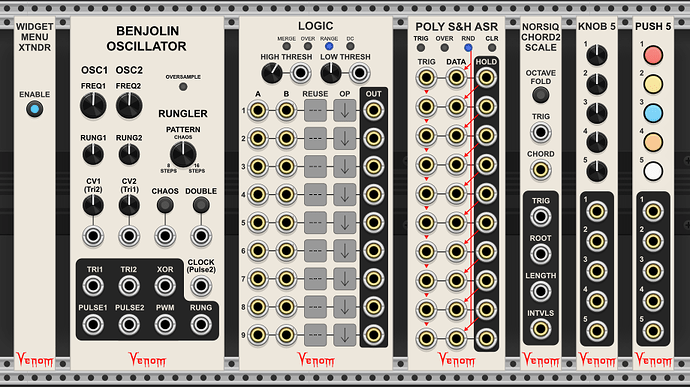Venom v2.6 just hit the library, and it has some exciting new modules and enhancements.
Enhancement - Custom Port/Parameter Names - documentation link
All Venom ports and parameters now have context menu options to rename the port or parameter. The custom name appears in the hover text and context menus, and is saved/restored with the patch. The custom names do not appear on the faceplate.
Widget Menu Extender - documentation link
This module brings custom port/parameter names and parameter user defaults to modules from other plugins, in much the same way that Venom modules do. It works by extending the context menus of foreign plugins to let you rename and set defaults. The names and defaults are saved and restored with the patch as long as the Widget Menu Extender remains in the patch.
This module can be of great use to anyone that works with VCV. It helps you annotate and keep track of large patches. The custom names can also be an aid during performance, or when sharing a patch with others.
The custom defaults are another good performance aid. It lets you set any control to your favorite sweet spot, and then during performance you can freely tweak the control, knowing you can instantly get back to your sweet spot with a double (or command) click.
Benjolin Oscillator - documentation link
My first oscillator - a wonderfully chaotic beast based on the Rob Hordijk masterpiece!
I love the sound of a Benjolin, and it is a blast to play with. This module makes it trivial to create a fully functioning Benjolin within VCV. It incorporates the two oscillators and the Rungler into a single module. You just need to add a resonant filter with good ping characteristics.
A fully functioning patch based on the Benjolin Oscillater is available on PatchStorage:
And here is a video showcasing an earlier version of the patch plus an additional Benjolin Oscillator. The Benjolin is great fun to tweak live, but this video is fully autogenerative with static configuration.
1.5 Venom Benjolins Air Windows.vcv (6.8 KB)
Logic - documentation link
An extremely flexible module capable of any combination of all the standard logic operations. There are a number of features that distinguish this module from all the other logic modules available to VCV:
- All the operators support one, two, or many inputs. Rows can be combined and/or polyphonic inputs can be merged into a set of inputs for one gate.
- Options for oversampling, output polarity, and DC offset removal make it ideal for processing audio inputs to generate novel sounds without unwanted aliasing or other artifacts.
- High and low thresholds are user configurable, making it easy to process a wide variety of signals.
- The output of one logic gate can be internally routed as input to a subsequent gate, making it possible to perform compound logic operations like ((A and B) or C), without introducing sample delays.
Poly Sample & Hold Analog Shift Register - documentation link
Ten rows of inputs and outputs that can be patched as any combination of independent sample and hold, and or shift registers. The module is very much inspired by the VCV S&H ASR, but with a number of major enhancements:
- Full support for polyphonic inputs and outputs, with a dizzying array of configurations possible
- Oversampling options for interesting audio effects without noticeable aliasing
- Internal random input (noise) is available for any of the data inputs, not just the top row.
Here is a patch and video demonstrating an interesting audio technique that the Poly S&H ASR makes possible:
Venom S&H Stepped Sine.vcv (6.8 KB)
And here is a patch with a video that explains the above technique, and demonstrates the profound impact oversampling can have:
Oversampled Venom Poly S&H ASR Demo.vcv (4.4 KB)
NORSIQ Chord to Scale - documentation link
Converts up to 14 channels of polyphonic “chord” input into a set of CV outputs that define a scale for the Non-Octave-Repeating Scale Intervallic Quantizer.
When paired with the quantizer, this module functions very much like the wonderful SIM Coerce module. But there is a major difference - this module can create non-octave repeating scales, opening up an entirely new world of harmonic possibilities.
Below is a beautiful piece I created using a scale based on an extended chord. It also nicely showcases the Venom Rhythm Explorer. An explanation of the patch is available here.
NORSIQ Chord To Scale Demo.vcv (8.1 KB)
And here is a patch and video that showcases the dynamic nature of the module, creating scales from randomly selected triads.
Stacked Random Triads.vcv (9.5 KB)
Knob 5 (documentation link) and PUSH 5 (documentation link)
These are deceptively deep “simple” control modules. Each knob or button can be independently configured.
Knobs:
- output range
- polyphony
Buttons:
- Mode: Trigger, Gate, or Toggle
- On and Off output values
- On and Off colors
- polyphony
And of course the standard Venom custom name and default options are available, making them even more useful.





